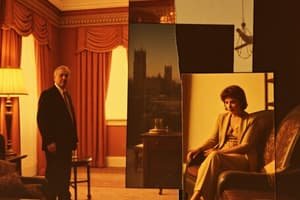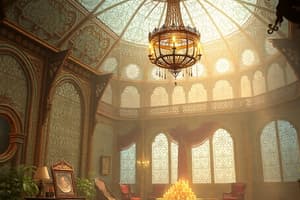Podcast
Questions and Answers
Which lighting technique emphasizes contrasts and shadows, often used to create a moody or ominous effect in film?
Which lighting technique emphasizes contrasts and shadows, often used to create a moody or ominous effect in film?
- High-key lighting
- Soft lighting
- Three-point lighting
- Chiaroscuro (correct)
What is the main purpose of using three-point lighting in film production?
What is the main purpose of using three-point lighting in film production?
- To balance lighting for a more natural effect (correct)
- To create a harsh contrast between light and dark
- To reduce shadows in the scene
- To enhance colors and saturation
In which scenario would high-key lighting be most appropriate?
In which scenario would high-key lighting be most appropriate?
- Highlighting an intense action sequence
- Filming a romantic scene with soft features (correct)
- Creating a suspenseful atmosphere
- Producing a horror film with dark undertones
What aspect of lighting refers to the path of light from its source to its object?
What aspect of lighting refers to the path of light from its source to its object?
What does the term 'lighting ratio' refer to in film lighting design?
What does the term 'lighting ratio' refer to in film lighting design?
Which lighting technique creates silhouettes by placing the light behind the subject?
Which lighting technique creates silhouettes by placing the light behind the subject?
In cinematography, which lighting aspect is directly related to the sharpness of shadows and textures?
In cinematography, which lighting aspect is directly related to the sharpness of shadows and textures?
What is the effect of using lighting from below in film?
What is the effect of using lighting from below in film?
In film composition, what is primarily affected by the organization and distribution of lighting?
In film composition, what is primarily affected by the organization and distribution of lighting?
What is a key lighting technique used in classical Hollywood filmmaking that typically involves three lights?
What is a key lighting technique used in classical Hollywood filmmaking that typically involves three lights?
Which type of lighting is known for eliminating shadows and providing an even illumination?
Which type of lighting is known for eliminating shadows and providing an even illumination?
Which statement best describes low-key lighting?
Which statement best describes low-key lighting?
Which film technique involves the careful arrangement and positioning of actors in a scene?
Which film technique involves the careful arrangement and positioning of actors in a scene?
Which of the following best defines the term 'mise-en-scene' in relation to lighting?
Which of the following best defines the term 'mise-en-scene' in relation to lighting?
What type of lighting is characterized by defined shadows and sharp edges?
What type of lighting is characterized by defined shadows and sharp edges?
Which aspect of lighting is used to provoke emotional responses in viewers?
Which aspect of lighting is used to provoke emotional responses in viewers?
How does low-key lighting contribute to the mood of a scene?
How does low-key lighting contribute to the mood of a scene?
In Psycho, how does lighting highlight Norman's character?
In Psycho, how does lighting highlight Norman's character?
What effect does the light filtering through slats of blinds create in a scene?
What effect does the light filtering through slats of blinds create in a scene?
How does lighting design influence the perception of Jay Gatsby’s character in The Great Gatsby?
How does lighting design influence the perception of Jay Gatsby’s character in The Great Gatsby?
What is emphasized by the low-key lighting on Charles Foster Kane?
What is emphasized by the low-key lighting on Charles Foster Kane?
What role does high-key lighting play in the portrayal of Susan Alexander?
What role does high-key lighting play in the portrayal of Susan Alexander?
What characterizes the lighting in the motel scene from Psycho?
What characterizes the lighting in the motel scene from Psycho?
In cinematic design, what is the primary purpose of lighting?
In cinematic design, what is the primary purpose of lighting?
Flashcards
Film Lighting
Film Lighting
Illumination that makes visible elements in a film frame, shaping its look and storytelling.
Lighting Quality
Lighting Quality
Relative intensity of illumination; hard light creates strong shadows, soft light is diffused.
Lighting Direction
Lighting Direction
Path of light from source to object; frontal, sidelight, backlighting, underlighting, toplighting.
Lighting Source
Lighting Source
Signup and view all the flashcards
Lighting Colour
Lighting Colour
Signup and view all the flashcards
Mise-en-scene
Mise-en-scene
Signup and view all the flashcards
High-Key Lighting
High-Key Lighting
Signup and view all the flashcards
Low-Key Lighting
Low-Key Lighting
Signup and view all the flashcards
Three-point lighting
Three-point lighting
Signup and view all the flashcards
Lighting ratio
Lighting ratio
Signup and view all the flashcards
Chiaroscuro
Chiaroscuro
Signup and view all the flashcards
Lighting from below
Lighting from below
Signup and view all the flashcards
Lighting in film
Lighting in film
Signup and view all the flashcards
Composition in film
Composition in film
Signup and view all the flashcards
Lighting in Horror Films
Lighting in Horror Films
Signup and view all the flashcards
Lighting Direction (Example)
Lighting Direction (Example)
Signup and view all the flashcards
Lighting in Psycho
Lighting in Psycho
Signup and view all the flashcards
Film Moods (Examples)
Film Moods (Examples)
Signup and view all the flashcards
Lighting in The Great Gatsby
Lighting in The Great Gatsby
Signup and view all the flashcards
Lighting and Character Design
Lighting and Character Design
Signup and view all the flashcards
Study Notes
Mise-en-scène
- Mise-en-scène encompasses the overall look and feel of a film, its attention to detail, and the arrangement of all elements within the frame.
- It's French for "putting on stage" and pronounced "meez-ahn-sen."
- It includes all elements visible in the frame that the director controls, whether intended or not.
- These elements include settings, props, lighting, costumes, makeup, and figure behavior (staging and acting, movement).
- Mise-en-scène blends elements of the art of theater.
- Key components include setting, character, lighting, and composition.
Central Elements of Mise-en-scène
- Setting: The physical location and environment
- Character: The actors, their appearances, and behaviors
- Lighting: The illumination used in a scene, influencing mood and visual effects
- Composition: The arrangement of elements within the frame
Key Figures and Examples
- George Méliès: A French filmmaker known for his meticulous attention to detail in film design, setting standards
- Fritz Lang: His 1927 film Metropolis displayed mechanized robotic characters and set designs for a dystopian narrative.
- Guillermo Del Toro: His film Pan's Labyrinth (2006) exemplifies how a character's design can be a mix of real-world inspiration (e.g. Goya's artwork or Manta rays) and artistic interpretation(e.g., the Pale Man).
- Alfred Hitchcock's Psycho: The house's exterior and interior design function as a character, and camera angles emphasize its imposing appearance. Setting, lighting, and the presence of specific props (the shower, knife) are used to create a mood and highlight the character traits of the characters.
Props
- Props are objects used by actors in a film, sometimes used simply for their common purpose but often metaphorically significant.
- Props can signify a character, thoughts, feelings, theme, or importance in the film.
- The knife in Psycho acts as a metaphor for Norman's dangerous tendencies.
- The toilet in Psycho is a first time example of a toilet's inclusion, a motif that signifies psychological and physical issues .
Character
- A screenwriter creates realistic characters within a narrative structure (e.g. believable personalities).
- Actors convincingly embody these characters through their performances.
- The physical design of the characters is crucial, e.g., character design via costume, makeup, and hairstyle (e.g., props, costumes, make-up, hairstyle), contributes to the mise-en-scène
- Character's look directly connects to the plot.
Actors, Stars, and Character Actors
- Actors in major roles, often celebrated internationally.
- Stars enhance film visibility because they're globally recognizable and act like brands.
- Casting decisions consider suitability for roles, the actors’ skills and potential marketability for promotion purposes.
- Actors portray a character realistically, e.g., with their performance evoking the character's inner identity in Psycho, with Norman Bates's social awkwardness.
- A star's charisma affects and focuses the mise-en-scène in a significant way.
- Important because a star's presence highlights certain elements and themes in a film.
Setting
- Location shoots offer real-world settings as opposed to studio settings, increasing costs but also providing a wide range of opportunities.
- Using a sound stage provides a professional shooting environment, as opposed to on-location shoots, which allow for better control over variables and costs.
- Special effects and computer-generated imagery (CGI) improve a film's setting, by example adding visual elements that cannot be created (or readily) on location or on a sound stage e.g. The Great Gatsby.
Set Design, Decor, Prop Selection
- Set design, décor and props work hand-in-hand to give a film a distinctive look, e.g., using and incorporating Art Deco in The Great Gatsby or a particular style of house/mansion in Psycho
- These factors contribute to a film's aesthetic and help to portray important visual or narrative themes to the viewer.
Lighting
- Lighting often contributes significantly to a film's general look and style, shaping its mood influencing its overall tone and style. e.g., horror films or Westerns.
- Elements include quality (hard or soft), direction (frontal, side, top), source (natural or artificial), and color.
- The overall mood and meaning of a scene are directly connected to lighting.
- High key lighting is associated with even, diffused light and minimal contrast; suitable for portraying innocence.
- Low key lighting uses significant contrast between light and dark and often adds a sense of mystery and unease.
Composition
- Composition describes the organization, distribution, balance, location, and relationship of characters and props in a shot.
- The Rule of Thirds is a conventional technique for composing images, which divides an image into horizontal and vertical thirds, helping create visual balance and continuity across shots.
- Kinesis includes character movement and visual elements in a shot to portray a character's mood or personality
- Elements like composition and movement can be significant for conveying a character's psychological state e.g., by using specific movements to portray a character's persona (e.g., a star's charisma).
Cinematic Style: German Expressionism
- In films, German Expressionism highly emphasizes stylized sets and lighting to evoke strong emotions and express human feelings and emotions.
- Extreme characterizations, e.g. emphasized performances techniques, e.g. exaggerated or overstated emotional displays, were common.
- Use of shadowy or low-key lighting, emphasized deep shadows and sharp contrasts.
Cinematic Style: Italian Neorealism
- This style emerged after World War II.
- The style emphasizes gritty, real-world settings and non-professional actors.
- The lighting and camera movements are often less controlled than in other cinematic traditions.
Design: Costume, Makeup, and Hairstyle
- Costumes, makeup, and hairstyles can visually depict a character's personality and emotional states, their social standing, and their general place/role in a film.
- Elements like design details, colours, and cultural references contribute to the overall look and style of a film.
- Choices of costumes, makeup, and hairstyles are also inspired by real sources such as historical figures or fictional characters to create a relevant persona.
Studying That Suits You
Use AI to generate personalized quizzes and flashcards to suit your learning preferences.




